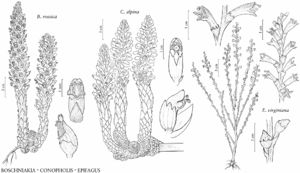Epifagus virginiana
Comp. Fl. Philadelph. 2: 50. 1818. (as virginianus)
Racemes usually with 1–12 erect or ascending branches, yellow, blackish purple, purplish brown, yellowish brown, or brown, (3.5–)15–45(–54) cm, arising from underground, ovoid, vegetative, cormlike structure covered with imbricate scale leaves and short, coralloid, adventitious, yellow to brownish orange roots; bracts triangular to ovate or ± awl-shaped, 2–5 mm. Pedicels 1–3 mm; bracteoles 2, adnate to base of calyx, triangular-ovate, 1–2 mm. Flowers: calyx 2–3 mm, lobes acuminate, 1 mm. Chasmogamous flowers: appearing bisexual, rarely producing fruit; corolla ± laterally compressed, 8–12 mm, abaxial lip with lobes erect to ± spreading, apex acute, adaxial lobe erect, slightly incurved apically, margins entire or notched; stamens included or barely exserted; stigma usually exserted. Cleistogamous flowers: corolla 2–3 mm. Capsules obliquely ovoid, laterally compressed, ± reniform in silhouette, thickest proximally, 3–4 × 3–3.5 mm, 2(or 3)-valved. Seeds 50 × 20 \mu, testa striate-reticulate.
Phenology: Flowering Jul–Oct.
Habitat: Mesic deciduous forests, mixed broadleaf-conifer forests.
Elevation: 0–1000 m.
Distribution
N.B., N.S., Ont., P.E.I., Que., Ala., Ark., Conn., Del., Fla., Ga., Ill., Ind., Ky., La., Maine, Md., Mass., Mich., Miss., Mo., N.H., N.J., N.Y., N.C., Ohio, Okla., Pa., R.I., S.C., Tenn., Tex., Vt., Va., W.Va., Wis., Mexico (Hidalgo, Tamaulipas).
Discussion
Epifagus virginiana is an obligate parasite of the American beech, Fagus grandifolia (Fagaceae). Its range is coincident with that of its host, including disjunct occurrences in the highlands of Hidalgo and Tamaulipas, Mexico (J. W. Thieret 1969d, 1971). Different degrees of anthocyanin production among populations have led to the description of two trivial color forms. Local common names such as cancer-root, clap-wort, and flux-plant allude to the historical belief that the plant was efficacious medicinally for a number of ailments (Thieret 1971).
Epifagus americana Nuttall is an illegitimate name for E. virginiana.
Selected References
None.
